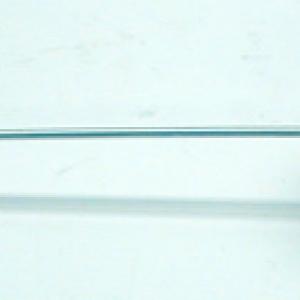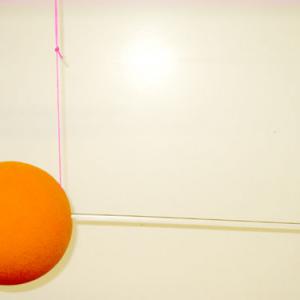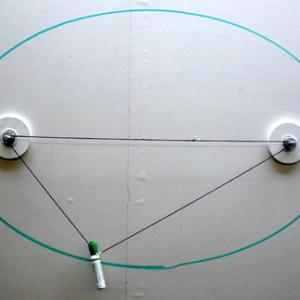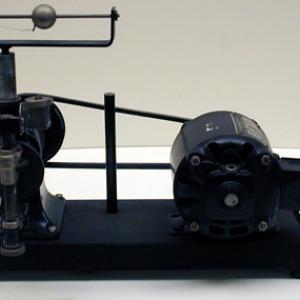College of Liberal Arts & Sciences
8B30.35 - Binary Star System - Eclipsing Binary or Trinary
Use either the PASCO powered rotating platform or the lazy susan one you can turn by hand. Both will work but the powered platform may give smoother and more reproducible light curves. Place two of the lights (suns) so that one is approximately 5 cm from the center of the platform and the other at a distance of about 13 cm on the opposite side of center. Set the light sensor to the 600 LUX range and bring it close enough to the bulbs so that it reads about 300 LUX when the bulbs are on the first setting. Rotate the platform and hit collect. An option is to use the dimmer second setting for one of the suns.
No advanced preparation needed for the 2-ball systems. Note that one of the systems models a red giant star with a small regular star or white dwarf binary. This model has a center of mass that is inside the red giant star as indicated by the pink string.
<p>The chalk boards in LR I and LR II are magnetic, so it is just a matter of carrying the apparatus to that room. In LR 70 you will have to move in the magnetic blackboard optics board for this demo as the chalkboard is not magnetic is that room.
A trinary sun system can be done by placing a third sun at the indicated position on the rotating platform. You can vary the light intensity of any of the suns using either the 1st or 2nd setting.
Note: This small binary apparatus is kept in the 1J10.09 Center of Mass Demos box. The small binary apparatus is designed to be used with the Cenco Rotator Unit.
Secure the apparatus in the chuck of the unit and slowly increase the rotation rate until a center of mass of the system is observed.
The air pollution slides found at 8B30.35 in the Astronomy section can be used to produce a hazy type of atmosphere for this demonstration.
- Joe Amato, "Motivating Introductory Physics Students Using Astronomy and Space Science", TPT, Vol. 54, #1, Jan. 2016, p. 56.
- Jennifer Hickman and Haym Kruglak, "An Exercise on the Altitude of the Noon Sun", TPT, Vol. 30, #4, Apr. 1992, p. 236.
- Charles A. Eckroth, "Earth and Moon Motions Around Their Common Center Of Mass", TPT, Vol. 28, #6, Sept. 1990, p. 425.
- Raymond H. Bloomer, Jr., "Indoor Astronomy: A Model Eclipsing Binary Star System", TPT, Vol. 17, #7, Oct. 1979, p. 456.
- Alan L. Breitler, "Binary Stars and Light Curves", TPT, Vol. 7, #8, Nov. 1969, p. 453.
- Edward Eisner, "Aberration of Light from Binary Stars - A Paradox?", AJP, Vol. 35, #9, Sept. 1967, p. 817.
- Alex Lopatka, "Elusive Helium Stars Indentified in Archival Data", Physics Today, Vol. 77, #2, Feb. 2024, p. 12.
- Bertram M. Schwarzschild, "Most Very Bright Stars Have Companions", Physics Today, Vol. 65, #9, Sept. 2012, p. 18.
- Charles Day, "White Dwarf is Caught Hurling Its Outer Layers at Its Red Giant Companion", Vol. 59, #10, Physics Today, Oct. 2006, p. 17.
- Gijs Nelemans, "Ultracompact Binary Stars", Physics Today, Vol. 59, #7, July 2006, p. 26.
- Judith Lean, "Living with a Variable Sun", Physics Today, Vol. 58, #6, June 2005, p. 32.
- Todd A. Thompson, Christopher S. Kochanek, Krzysztof Z. Stanek, Carles Badenes, Richard S. Post, Tharindu Jayasinghe, David W. Latham, Allyson Bieryla, Gilbert A. Esquerdo, Perry Berlind, Michael L. Calkins, Jamie Tayar, Lennart Lindegren, Jennifer A. Johnson, Thomas W.-S. Holoien, Katie Auchettl, and Kevin Covey, "A Noninteracting Low-Mass Black Hole–Giant Star Binary System", Science, Vol. 366, #6465, Nov. 2019, p. 637.
- F. O. Alves, P. Caselli, J. M. Girart, D. Segura-Cox, G. A. P. Franco, A. Schmiedeke, and B. Zhao, "Gas Flow and Accretion via Spiral Streamers and Circumstellar Disks in a Young Binary Protostar", Science, Vol. 366, #6461, Oct. 2019, p. 90.
- Herbert Gursky and Edward P. J. van den Heuvel, "X-Ray Emitting Double Stars", Scientific American, Vol. 232, #3, Mar. 1975, p. 24.
- G. D. Freier and F. J. Anderson, "Mp-8. An Earth-Moon System", A Demonstration Handbook for Physics.
- David Kutliroff, "58, An Argument for a Heliocentric Planetary System", 101 Classroom Demonstrations and Experiments For Teaching Physics, p. 129 - 131.
- "Modeling the Study of Extrasolar Planets with the Vernier Light Sensor", The Caliper, Fall 2011, Vol. 28, #2, p. 4.
- "Solar System in a Box", The Caliper, Fall 2010, Vol. 27, #2, p. 3.
- James C. Kernohan, "4. Binary Star and Center of Mass", PIRA News, Vol. 9, #3, Jan. 1995, p. 22.
- Janice VanCleave, "28. Balancing Point", Janice VanCleave's Astronomy for Every Kid - 101 Easy Experiments That Really Work, p. 62 - 63.
- Janice VanCleave, "10. In Place", Janice VanCleave's Astronomy for Every Kid - 101 Easy Experiments That Really Work, p. 24 - 25.
- Janice VanCleave, "40. Uneven", Janice VanCleave's 204 Sticky, Gloppy, Wacky, and Wonderful Experiments, p. 23.
- Janice VanCleave, "39. Pairs", Janice VanCleave's 204 Sticky, Gloppy, Wacky, and Wonderful Experiments, p. 23.
- Janice VanCleave, "26. Cover-up", Janice VanCleave's 204 Sticky, Gloppy, Wacky, and Wonderful Experiments, p. 16.
- D. Tattersfield, "7.36 Binary Star Orbits", Project & Demonstrations in Astronomy, p. 182 - 189.
- James A. Van Allen, "Mean Free Paths of Solar Electrons (Ee > 4 keV) in the Interplanetary Medium", Journal of Geophysical Research, Vol. 103, # A12, Dec. 1998, p. 29,655.
- Hangkun Ung and Gerald Zani, "8B30.35 Binary Star", Brown University Physics Labs.
- Eclipsing Binary Starts Video, University of Nebraska at Lincoln.
- Joseph Frick, "Experiments With the Whirling Machine", Physical Technics; Or, Practical Instructions for Making Experiments in Physics and the Construction of Physical Apparatus with the Most Limmited Means, p. 139.
Disclaimer: These demonstrations are provided only for illustrative use by persons affiliated with The University of Iowa and only under the direction of a trained instructor or physicist. The University of Iowa is not responsible for demonstrations performed by those using their own equipment or who choose to use this reference material for their own purpose. The demonstrations included here are within the public domain and can be found in materials contained in libraries, bookstores, and through electronic sources. Performing all or any portion of any of these demonstrations, with or without revisions not depicted here entails inherent risks. These risks include, without limitation, bodily injury (and possibly death), including risks to health that may be temporary or permanent and that may exacerbate a pre-existing medical condition; and property loss or damage. Anyone performing any part of these demonstrations, even with revisions, knowingly and voluntarily assumes all risks associated with them.




